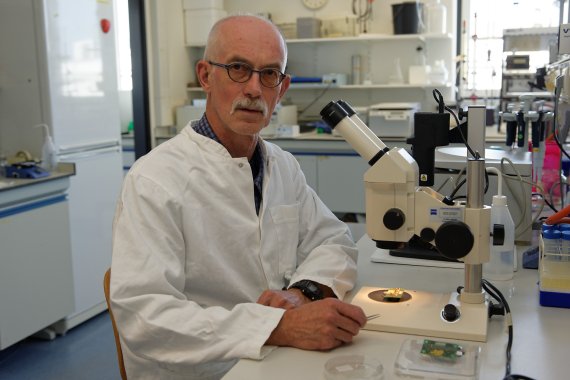The sensor is based on a prototype chip produced by Eindhoven- based company NXP. The gadget is one quarter by one quarter of a millimetre in size and contains about 65,000 pixels. Because each of these can separately measure the electrical characteristics of its immediate environment, with all the pixels put together you get an electric image of a cell in a very high resolution, explain researchers Maarten Jongsma and Harrie Verhoeven. They have used this technology to make a film of an aggressive cancer cell trying to attach itself to the surface of the chip. The film is on resource-online.nl.
Cells have an electrical field around them, explains Verhoeven, but you cannot usually see it. NXP’s sensor makes its own electrical fi eld and the degree to which it is disturbed tells us what is up with the cell. The research required input from three scientifi c fi elds. The Italian researchers created a mathematical model that describes how the sensor should work. The Twente researchers calibrated the sensor with miniscule plastic and gold droplets in order to be able to interpret the disturbance to the electrical fi eld properly. And the Wageningen researchers hit upon the idea of using the nanosensor to study cells and supplied the knowledge of cells that was needed.
Nanochip maakt filmpje van kankercel
To date researchers usually examine cells with an optical microscope, but that does not provide any information about the electrical state of the cell. This new method provides you with a new kind of camera for examining cells, says Jongsma. ‘It is an electrical gadget with which we can actually measure the energy balance of the cell,’ says Verhoeven. They published their finding this month in the top journal Nature nanotechnology.
It is an electrical gadget with which we can actually measure the energy balance of the cell
What kind of new insights the miniscule camera chip will provide, the researchers do not know yet. ‘Now we have shown what the camera can register,’ says Verhoeven. ‘The fi lm speaks for itself.’ The technique could help medical researchers with their cancer research, to fi nd out whether anti- cancer medicines are taking effect, for instance. But it could also be used in research on plant cells or for registering entirely different processes at cell level. To make this possible, the chip still needs fine-tuning, says Verhoeven. By varying the frequency at which measurements are taken, you can change the depth of the image. He would also like to do further research on exactly what the images captured by the nano camera show.To this end he wants to measure cells simultaneously with a fl uorescence microscope and these electrical sensors, ‘so that we can pinpoint exactly what they see.’ As the camera is a new way of looking inside cells, he expects it to generate new insights in cell biology.
At present the CMOS (complementary metal-oxide semiconductor) chip can only take photos of cells outside the body. Jongma and Verhoeven do not exclude the possibility of making an even smaller nano camera that could navigate through our bodies recording cells.

